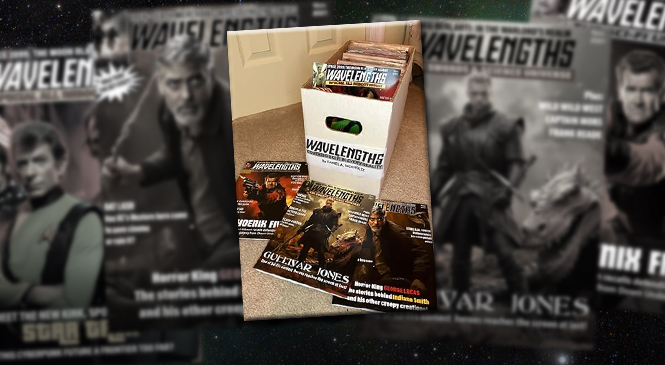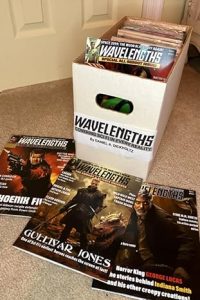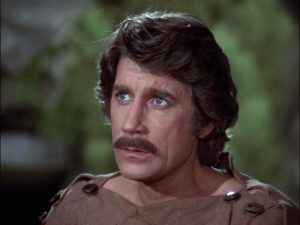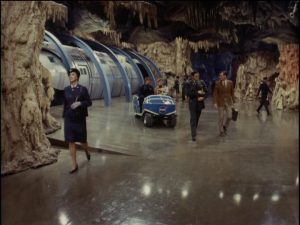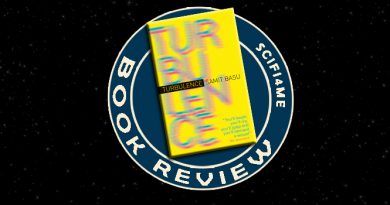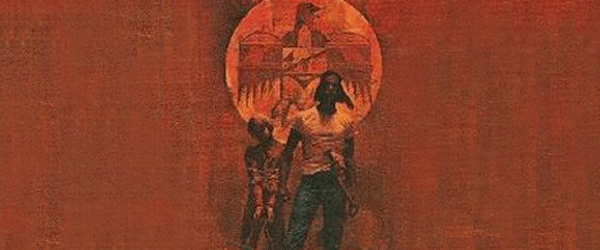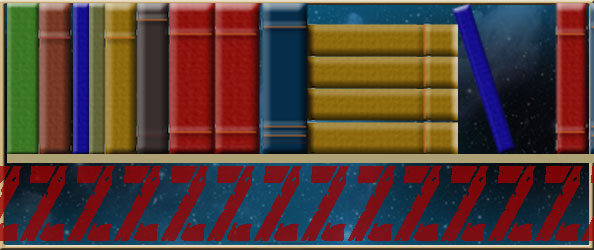Dan Dickholtz Travels New WAVELENGTHS

Imagine a world where George Lucas was known more for his string of horror movies rather than Star Wars. Imagine Gene Roddenberry with more hit series in the seventies — Planet Earth, maybe The Questor Tapes or Battleground: Earth starring Tom Selleck.
That’s just what author and journalist Daniel Dickholtz has done with his new book Wavelengths, collecting Starlog-type material in an anthology of stories from alternate universes.
“It’s three different alternate histories of science fiction media, but it’s told in the form of the articles, the book reviews, the letters pages, the editorials of a magazine that, by sheer coincidence, happens to be just like Starlog, called Wavelengths.” And it’s not just one alternate universe, it’s three. “The contents of the magazine change from one universe to the next. So what we’re actually seeing is just like a sampling of the magazine, like if you had gone to the magazine’s web site and you wanted to get a taste of what the magazine was like. And what you’re seeing is issue 501, which is a Fall issue from 2019, because that’s the year I started the real hardcore work on it. In one universe, the magazine might look like this. In another universe, it could look like this. And in still another universe, it looks like this.”
Wavelengths is set up to be a magazine like Starlog, Fangoria, Comics Scene, etc. in that it covers the science fiction and fantasy entertainment industry with articles, reviews, and interviews. There’s even a letters column. Dickholtz took his inspiration from his time on the staff of Starlog (which you can read about in our tribute here). “We used to do these things called Starlog Yearbook, and a lot of that would be reprinted. We’d also throw in some articles that we couldn’t fit in the regular magazine. And one time as I was going through it, it’s like you know what? We’ve got this news item or this portion of an article that was about a project that didn’t get made, and I thought it would be pretty interesting if we could just assemble all of them into one alternate universe Starlog Yearbook. But that would have taken a lot of time and effort, and when you’re putting out several monthly magazines, there was no way to actually invest the time in it.”
Years after Starlog was cancelled, the idea stuck. Dickholtz kept seeing anthologies and story collections published over the years, and he figured at some point maybe he could “get the old gang back together” to assemble the alternate universe Yearbook. However, faced with the prospect of having to wade through contracts and other elements of assembling such a project, he figured to make the first one on his own and reduce the stress. “The more I thought about it, and relying just entirely on myself, I thought ‘what do I know about contracts?’ Could I even get everybody back together? Would some of these people even still want to do anything like that? And as I started just jotting down notes, I kept thinking, ‘I’m the one who really has some vision for what I want to do and I’m being very particular about it. Maybe I should just do it myself.’”
Working from notes collected over the years, Dickholtz quickly found himself looking at different possibilities compounding exponentially, as one random element would impact several other items, such as which Roddenberry project between Planet Earth and Genesis II would be the success story.
“Gene Roddenberry had done a pilot for Genesis II. He had very high hopes for it. He had already written out a massive bible for it. He had written up a number of story treatments, and he got to film it in 1973 with Alex Cord in the lead role, and came that close to getting picked up. When it didn’t, he went over to another network the very next year. He picked one of the other story treatments, and they developed that into Planet Earth with John Saxon taking over the Alex Cord role, but essentially it’s the sequel. Planet Earth was the one that I had seen as a kid before I saw Genesis II, and in a way that’s kind of the – that may actually be the whole impetus for this because for whatever reason, I really liked Planet Earth. I could see exactly what he was trying to do with it. But when it came to doing this, it’s like ‘OK, are we having Genesis II become the series, or are we having Planet Earth become the series?’ Because there’s a year of difference that’s going on there, and that means that other things didn’t have opportunities and if I really didn’t want to deal with those. I kept on going back and forth and it came down to actually the ratings. Planet Earth at that time did not get great ratings, and Genesis II did and, like I said, came that close. So I said, ‘ok, I’m sticking with Genesis II and so Planet Earth, that story is just another episode that they do. But that’s the kind of thing that I had to stick with, because if it’s one year, it becomes one set of things. If it’s a different year, it goes off in a whole different direction.”
Another Roddenberry project that got picked up in this universe in the seventies: Battleground: Earth, which in this universe wasn’t produced until after Roddenberry’s death and was re-christened Earth: Final Conflict. But at the time Roddenberry originally pitched it, he had become aware of a little-known actor who was making it into pilots that were never picked up. “But he had faith in Tom Selleck. And well, that changes a couple of things because if that show gets on the air, then that means that Tom Selleck isn’t going to be around, he’s not going to be available if it’s a hit show, for another pilot called Magnum, P.I. Somebody else gets that part.” According to Wavelengths, Selleck went on to become a science fiction icon.
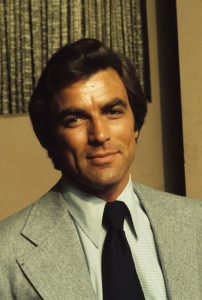
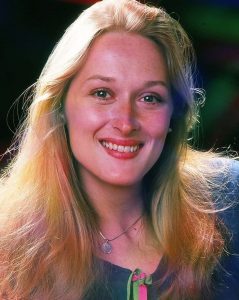 As did Meryl Streep, who auditioned for Dino De Laurentis’ King Kong. Dickholtz had discovered in his research, that De Laurentis’ son had brought her in for an audition, and the elder producer called her “ugly” (in Italian), and she ended up telling him off because she understood Italian. Dickholtz had only jokingly thought about creating a new history for Streep when he learned of the audition. “The mere fact that she was knocking around and she was willing to show up for a King Kong movie, I said ‘OK, well, I’m doing the 1970s, she’s knocking around. I’m sticking her in this other project.’” Which is how Meryl Streep and Robert Englund ended up in project together.
As did Meryl Streep, who auditioned for Dino De Laurentis’ King Kong. Dickholtz had discovered in his research, that De Laurentis’ son had brought her in for an audition, and the elder producer called her “ugly” (in Italian), and she ended up telling him off because she understood Italian. Dickholtz had only jokingly thought about creating a new history for Streep when he learned of the audition. “The mere fact that she was knocking around and she was willing to show up for a King Kong movie, I said ‘OK, well, I’m doing the 1970s, she’s knocking around. I’m sticking her in this other project.’” Which is how Meryl Streep and Robert Englund ended up in project together.
It’s that later knowledge, the stuff we learn along the way as interviews and tell-all books get published over the years, that sometimes color our perceptions of what went on back in the day. A lot of what we know about Star Wars, for example, comes from later chronicles of behind-the-scenes stories, not from media coverage at the time. Who knew that Marcia Lucas or Gary Kurtz (among others) were so instrumental in making the film work as well as it did? How many of us knew Splinter of the Mind’s Eye was originally conceived as a possible lower-budget sequel in the eventuality that Star Wars was a flop?
“As I was doing some of the research for this, particularly with Star Wars, even though I’d much prefer to have one incident send everything off on its unusual way, I quickly found that they had done so much ground work before the movie came out, that I had to knock away a few different support beams before I got to the result where it really all starts to fall apart. Reading a number of interviews with Roy Thomas and Charlie Lippincott and a number of other people, to see they were really banging their heads against the wall trying to get this done and that done. Even trying to get toy deals done. And all of this was being done so that they could prep the audience. Because I didn’t want to have a situation where the audience just went ‘meh’ – there had to be stuff going on before that for that to be a result. And certainly, I wouldn’t have been able to do a lot of that if it wasn’t for everything that’s come out since.” The success of Star Wars had come out of not just a great film, but the preliminary hype surrounding the Kenner action figures and other merchandise.
That success eluded George Lucas in these other dimensions. “I remember hearing one podcast where I think they were quoting Francis Ford Coppola, who said that George doesn’t like to lose. And I kept thinking about that as I was writing it, because my original idea was that he was just going to own a video store. There is a little element of that within there, but in the end, he comes out of that and goes on to more. Because like I said, there is always good in something. There is always something that’s worthwhile, and I just want to – I’m really trying to celebrate everything.”
That “always good in something” is an optimistic viewpoint. Even with TV series and films that don’t quite work right, Dickholtz says we should make the effort to see something good in the project. And that applies to fandom overall, no matter the franchise. “The people who are just hung up on the past are just not as happy as the people who are just nostalgic. Because they’re taking things from the past and doing something fresh and new and they’re inspired by it. Some of that was coming from the fact that I see different fandoms where they suddenly just say, ‘whatever this new thing is, it’s awful, it’s terrible, it’s no damn good! Only the one that was done originally, or maybe the one that went after that, only that is good. No, that’s you being hung up. That day happened. It’s not coming back. Let’s see this new thing.”
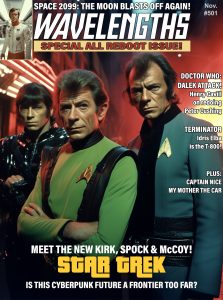 It should be noted that disgruntled fans are not new. This kind of thing has been going on for many, many years. Those of us who were there back in the day will remember the frustration and consternation over the announcement that Paramount was moving forward with Star Trek: The Next Generation. And how many times have Whovians declared that this new Doctor can’t possibly as good as the previous Doctor (by the way, Tom Baker is still the best Doctor…)! “Back in 1989, after Batman came out, we got a letter from somebody – because there was no internet; our letters pages were the internet of the time – and somebody wrote in complaining bitterly that Kim Basinger was playing Vicky Vale as a blonde when she was a redhead in the comics. I just turned to one of the other editors and said, ‘I didn’t realize that her entire character is based on her hair color. I suppose the next thing we’re going to get is a letter complaining that Batman’s costume is all black, which makes sense, as opposed to grey and blue like in the comics.’ The very next day, that’s the letter we got.”
It should be noted that disgruntled fans are not new. This kind of thing has been going on for many, many years. Those of us who were there back in the day will remember the frustration and consternation over the announcement that Paramount was moving forward with Star Trek: The Next Generation. And how many times have Whovians declared that this new Doctor can’t possibly as good as the previous Doctor (by the way, Tom Baker is still the best Doctor…)! “Back in 1989, after Batman came out, we got a letter from somebody – because there was no internet; our letters pages were the internet of the time – and somebody wrote in complaining bitterly that Kim Basinger was playing Vicky Vale as a blonde when she was a redhead in the comics. I just turned to one of the other editors and said, ‘I didn’t realize that her entire character is based on her hair color. I suppose the next thing we’re going to get is a letter complaining that Batman’s costume is all black, which makes sense, as opposed to grey and blue like in the comics.’ The very next day, that’s the letter we got.”
Of course, on the other end of the spectrum are those people who have only a passing, peripheral knowledge about such things. They don’t know Peter Parker from Miles Morales, nor do they know the names of all the Power Rangers, nor do they have the complete history of the planet Yavin in their heads. Dickholtz worked to make sure the book would be accessible for those people as well. “Even though there are time where I get, like, really inside baseball, where you really have to know – like, for example, in one section you really have to know about Charlton Comics and Gold Key Comics, neither of which have been around for decades. At the same time that I’m doing that for the people who know, I also have to be mindful that there will be people who wouldn’t.” The casual reader is just as important, which means some things would need a little bit more explanations. “I had to be mindful that there are some things that I would have to either explain more or the theme of it had to be broad enough that it would appeal to anybody even if you didn’t know this particular thing.”
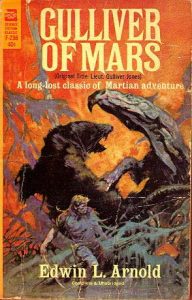
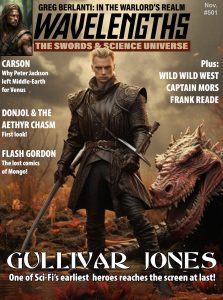 Even some long-time fans might not get every reference. “I’m figuring most people don’t know who Gulliver Jones is. Unless you’re really into old, old science fiction, or you’re into sword-and-planet novels to begin with, the average person isn’t going to know Gulliver Jones, which of course is why I seized upon him. There are a number of different properties that are filtered throughout that most people wouldn’t know, so I take an extra step in explaining it. But for me, the important thing is that I give enough detail about everything that you buy into the world, that if you were to just be dropped into this world and you happen to open up this particular issue, you can believe that all of it could exist, that it’s at least a plausible sounding world.”
Even some long-time fans might not get every reference. “I’m figuring most people don’t know who Gulliver Jones is. Unless you’re really into old, old science fiction, or you’re into sword-and-planet novels to begin with, the average person isn’t going to know Gulliver Jones, which of course is why I seized upon him. There are a number of different properties that are filtered throughout that most people wouldn’t know, so I take an extra step in explaining it. But for me, the important thing is that I give enough detail about everything that you buy into the world, that if you were to just be dropped into this world and you happen to open up this particular issue, you can believe that all of it could exist, that it’s at least a plausible sounding world.”
It’s also good to know that in some universes, John Carter finally got his due, with Tom Cruise producing a series of successful adaptations in the 1990s. (For the real story on why it’s never happened, read John Carter and the Gods of Hollywood by Michael D. Sellars.) “With just taking Tom Cruise making John Carter back in the 90s, what we mostly follow there is a set visit to a TV mini-series version of Gulliver Jones, which is a book that preceded the John Carter books, finally getting made.”
It’s the kind of thing we grew up reading in Starlog, and that magazine’s legacy is stamped onto Wavelengths. “We wind up seeing little bits of everything; the books you might have been reading, the comics you might have been collecting, the toys and chachkas that you could be picking up at conventions. You hear about other projects that are in the works. Each one of these leads to tremendous changes throughout the industry, throughout the genre, and how fans react to all of these different things.”
And the narrative voice is very similar to what you would find in those magazines back in the day. “As I was writing it, I had to keep on thinking of it, ‘ok, I can’t just be an omniscient narrator. What would the writer who lives in this world, how would he approach it?’ because there are certain things that he’s going to know about and there are certain things he couldn’t possibly know about. Which actually, weirdly, sort of became more and more self-reflective. Because it’s like, ‘ok, well, how much did we really know about everything that was going on some of these movies?’ Were we just being told what they wanted us to hear?”
That time at Starlog clearly has influenced the work, and Dickholtz is quick to make that connection more than once. “If you look at the dedication page, the dedication page is really to practically everybody who worked on Starlog back in the day, especially the editor Dave McDonnell. Because there’s a what if. If he hadn’t hired me, I wouldn’t have a book today.”
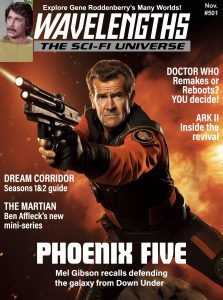 Dickholtz also plans to supplement the first book with videos on his YouTube channel as a way of adding more depth to the various alternate universes. “I really want to make a few videos where I discuss the lesser known things. Like even, for example, we mention Gulliver Jones, but in this one, we’ve got that movie series Phoenix Five. That was a real thing. That was a real Australian science fiction TV show from the early seventies. And after I had posted some of the covers, somebody from Australia, ‘that would make a great series of movies. How come nobody’s doing that?’ Well, they did in this universe.”
Dickholtz also plans to supplement the first book with videos on his YouTube channel as a way of adding more depth to the various alternate universes. “I really want to make a few videos where I discuss the lesser known things. Like even, for example, we mention Gulliver Jones, but in this one, we’ve got that movie series Phoenix Five. That was a real thing. That was a real Australian science fiction TV show from the early seventies. And after I had posted some of the covers, somebody from Australia, ‘that would make a great series of movies. How come nobody’s doing that?’ Well, they did in this universe.”
Returning to the idea of future Wavelength collections including other Starlog alumni, Dickholtz says it would be a “fun idea” for a future volume, and he has ideas for more should the first book be successful enough. “There are a few realities that I’ve been thinking about that I just didn’t quite find the right hook, but I keep thinking about them, and I’d certainly like to get into a world where the James Bond movies turned out differently. There’s another one that’s focused on luchador movies. Because why not? I mean, you’ve got guys in masks fighting monsters. That’s superhero stuff right there.
“I have three strong contenders. It’s just a matter of finding the right hooks, what the theme of it is going to be. Because really, each one of these is a story. I mean, as much as I love the world-building, and there’s a lot of world-building here, there’s still themes that I want to deal with that are going to be meaningful to more than just the casual reader. I want to make sure that I’ve got something where the subject matter and what I’m doing with it will fit together. And of course, it’s also a matter of do I have the timing right, because there was one idea where I was thinking ‘ok, so if I have this happen, then the magazine would be covering it in this decade, but what would be happening after?’ And it is a challenging thing, doing thirty to fifty years’ worth of rewriting pop culture history.”
![]()

